Chronic Myeloid Leukemia (CML)
Access exceptional care for chronic myeloid leukemia and other types of blood and bone marrow cancers at Montefiore Einstein Comprehensive Cancer Center. Our multidisciplinary team has extensive experience caring for this cancer. As one of the first NCI-designated cancer centers for more than 50 years, we’ve been a leader in the research, diagnosis and treatment of over 200 types of cancer.
We’re at the forefront of treatment and research for chronic myeloid leukemia and other blood and bone marrow cancers, including clinical trials. Our clinical research team ensures you have access to a robust offering of clinical trials here at our cancer center. These trials focus on everything from immunotherapy, which harnesses the power of your own immune system to fight cancer, to targeted therapies based on your cancer’s specific biology.
When you need chronic myeloid leukemia care, turn to our providers who are passionate about ending cancer and addressing your whole health needs.

Cancer Clinical Trials
- Blood & Bone Marrow Cancers
- Brain, Spine & Central Nervous System Cancers
- Breast Cancer
- Childhood Cancers
- Endocrine System Cancers
- Gastrointestinal (GI) Cancers
- Genitourinary (GU) & Urologic Cancers
- Gynecologic Cancers
- Head & Neck Cancers
- Kaposi Sarcoma & AIDS-Related Cancers
- Lung & Chest Cancers
- Prostate Cancer
- Sarcomas
- Skin Cancer
As an NCI-designated comprehensive cancer center, Montefiore Einstein Comprehensive Cancer Center supports the mission and guidelines of the National Cancer Institute (NCI). The following information about types of cancer, prevention and treatments is provided by the NCI.
Chronic Myeloid Leukemia Treatment (PDQ®)–Patient Version
General Information About Chronic Myeloid Leukemia
Key Points
- Chronic myeloid leukemia is a disease in which the bone marrow makes too many white blood cells.
- Leukemia may affect red blood cells, white blood cells, and platelets.
- Signs and symptoms of chronic myeloid leukemia include weight loss and tiredness.
- Most people with chronic myeloid leukemia have a gene mutation (change) called the Philadelphia (Ph) chromosome.
- Tests that examine the blood and bone marrow are used to diagnose chronic myeloid leukemia.
- Certain factors affect prognosis (chance of recovery) and treatment options.
Chronic myeloid leukemia is a disease in which the bone marrow makes too many white blood cells.
Chronic myeloid leukemia (also called CML or chronic myelogenous leukemia) is a slowly progressing blood and bone marrow disease that usually occurs during or after middle age and rarely occurs in children.

Anatomy of the bone. The bone is made up of compact bone, spongy bone, and bone marrow. Compact bone makes up the outer layer of the bone. Spongy bone is found mostly at the ends of bones and contains red marrow. Bone marrow is found in the center of most bones and has many blood vessels. There are two types of bone marrow: red and yellow. Red marrow contains blood stem cells that can become red blood cells, white blood cells, or platelets. Yellow marrow is made mostly of fat.
Leukemia may affect red blood cells, white blood cells, and platelets.
Normally, the bone marrow makes blood stem cells (immature cells) that become mature blood cells over time. A blood stem cell may become a myeloid stem cell or a lymphoid stem cell.
A myeloid stem cell becomes one of three types of mature blood cells:
- red blood cells that carry oxygen and other substances to all tissues of the body
- platelets that form blood clots to stop bleeding
- granulocytes (white blood cells) that fight infection and disease
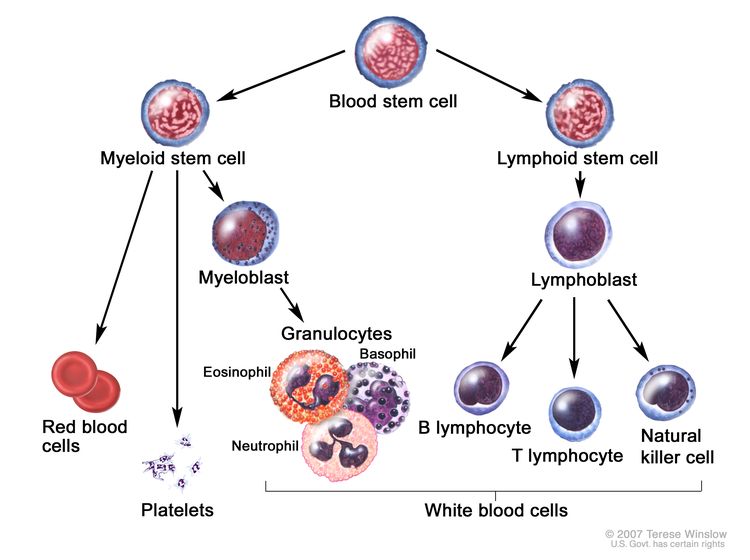
Blood cell development. A blood stem cell goes through several steps to become a red blood cell, platelet, or white blood cell.
In CML, too many myeloblasts (a type of immature white blood cell) form in the blood and bone marrow, and the disease worsens as the number of myeloblasts increases.
CML is one of a group of diseases called myeloproliferative neoplasms.
Signs and symptoms of chronic myeloid leukemia include weight loss and tiredness.
These and other signs and symptoms may be caused by CML or by other conditions. Check with your doctor if you have:
- fatigue (feeling very tired)
- weight loss for no known reason
- drenching night sweats
- fever
- pain or a feeling of fullness below the ribs on the left side
Sometimes CML does not cause any symptoms at all.
Most people with chronic myeloid leukemia have a gene mutation (change) called the Philadelphia (Ph) chromosome.
Every cell in the body contains DNA (genetic material) that determines how the cell looks and acts. DNA is contained inside chromosomes. In CML, part of the DNA from one chromosome moves to another chromosome. This change is called the "Philadelphia chromosome." It results in the bone marrow making a protein, called tyrosine kinase, that causes too many stem cells to become white blood cells (granulocytes or blasts).
The Philadelphia chromosome is not passed from parent to child.
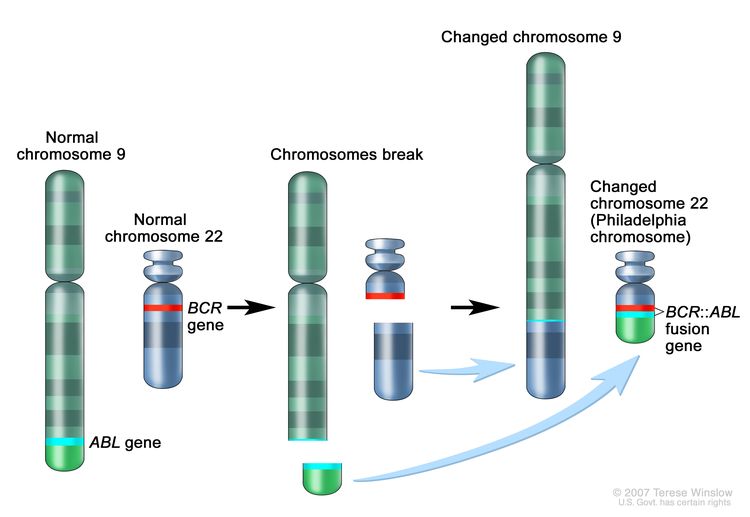
The Philadelphia (Ph) chromosome is an abnormal chromosome that is made when pieces of chromosomes 9 and 22 break off and trade places. The
ABL1 gene from chromosome 9 joins to the
BCR gene on chromosome 22 to form the
BCR::
ABL1 fusion gene. The changed chromosome 22 with the fusion gene on it is called the Ph chromosome.
Tests that examine the blood and bone marrow are used to diagnose chronic myeloid leukemia.
In addition to asking about your personal and family health history and doing a physical exam to check for signs of disease, such as an enlarged spleen, your doctor may perform the following tests and procedures:
- Complete blood count (CBC) with differential checks a sample of blood for:
- the number of red blood cells and platelets
- the number and type of white blood cells
- the amount of hemoglobin (the protein that carries oxygen) in the red blood cells
- the amount of hematocrit (whole blood that is made up of red blood cells)
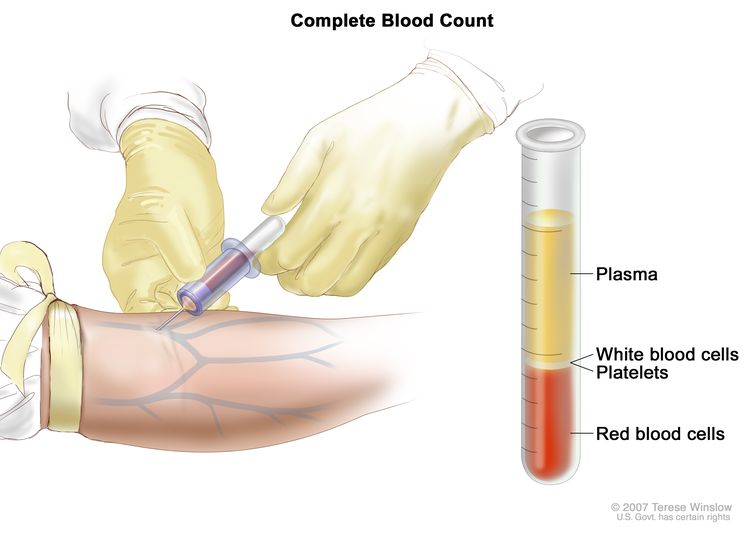
Complete blood count (CBC). Blood is collected by inserting a needle into a vein and allowing the blood to flow into a tube. The blood sample is sent to the laboratory and the red blood cells, white blood cells, and platelets are counted. The CBC is used to test for, diagnose, and monitor many different conditions.
- Blood chemistry study uses a blood sample to measure the amounts of certain substances released into the blood by organs and tissues in the body. An unusual amount of a substance can be a sign of disease.
- Bone marrow aspiration and biopsy is the removal of bone marrow, blood, and a small piece of bone by inserting a needle into the hipbone or breastbone. A pathologist views the bone marrow, blood, and bone under a microscope to look for abnormal cells.
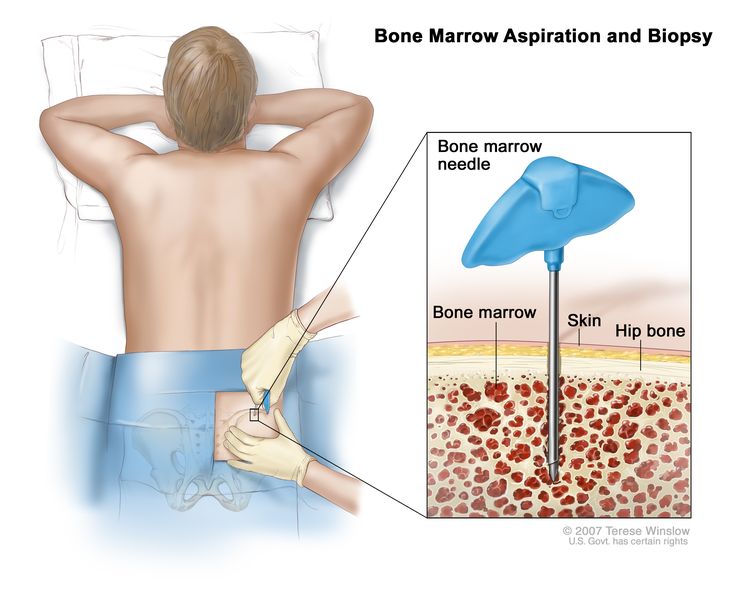
Bone marrow aspiration and biopsy. After a small area of skin is numbed, a long, hollow needle is inserted through the patient's skin and hip bone into the bone marrow. A sample of bone marrow and a small piece of bone are removed for examination under a microscope.
One of the following tests may be done on the samples of blood or bone marrow tissue that are removed.
- Cytogenetic analysis checks the chromosomes of cells in a sample of bone marrow, blood, tumor, or other tissue for broken, missing, rearranged, or extra chromosomes. Changes in certain chromosomes, such as the Philadelphia chromosome, may be a sign of cancer. Cytogenetic analysis is used to help diagnose cancer, plan treatment, or find out how well treatment is working.
- FISH (fluorescence in situ hybridization) is a laboratory test used to look at and count genes or chromosomes in cells and tissues. Pieces of DNA that contain fluorescent dyes are made in the laboratory and added to a sample of a patient's cells or tissues. When these dyed pieces of DNA attach to certain genes or areas of chromosomes in the sample, they light up when viewed under a fluorescent microscope. The FISH test is used to help diagnose cancer and help plan treatment.
- Reverse transcription–polymerase chain reaction test (RT-PCR) is a laboratory test in which the amount of a genetic substance called mRNA made by a specific gene is measured. An enzyme called reverse transcriptase is used to convert a specific piece of RNA into a matching piece of DNA, which can be amplified (made in large numbers) by another enzyme called DNA polymerase. The amplified DNA copies help tell whether a specific mRNA is being made by a gene. RT-PCR can be used to check the activation of certain genes that may indicate the presence of cancer cells. This test may be used to look for certain changes in a gene or chromosome, which may help diagnose cancer.
Certain factors affect prognosis (chance of recovery) and treatment options.
The prognosis and treatment options depend on:
- the patient's age
- the phase of CML
- the amount of blasts in the blood or bone marrow
- the patient's general health
Stages of Chronic Myeloid Leukemia
Key Points
- After chronic myeloid leukemia has been diagnosed, tests are done to find out if the cancer has spread.
- Chronic myeloid leukemia has 3 phases.
- Chronic phase
- Accelerated phase
- Blastic phase
- Chronic myeloid leukemia can relapse (return) after it has been treated.
After chronic myeloid leukemia has been diagnosed, tests are done to find out if the cancer has spread.
The extent or spread of cancer is usually described as stages. In chronic myeloid leukemia (CML), the disease is classified by phase: chronic phase, accelerated phase, or blastic phase. It is important to know the phase in order to plan treatment. The information from tests and procedures done to diagnose chronic myeloid leukemia is also used to plan treatment.
Chronic myeloid leukemia has 3 phases.
As the amount of blast cells increases in the blood and bone marrow, there is less room for healthy white blood cells, red blood cells, and platelets. This may result in infections, anemia, and easy bleeding, as well as bone pain and pain or a feeling of fullness below the ribs on the left side. The number of blast cells in the blood and bone marrow and the severity of signs or symptoms determine the phase of the disease.
Chronic phase
In chronic phase CML, fewer than 10% of the cells in the blood and bone marrow are blast cells.
Accelerated phase
In accelerated phase CML, 10% to 19% of the cells in the blood and bone marrow are blast cells.
Blastic phase
In blastic phase CML, 20% or more of the cells in the blood or bone marrow are blast cells. When tiredness, fever, and an enlarged spleen occur during the blastic phase, it is called blast crisis.
Chronic myeloid leukemia can relapse (return) after it has been treated.
In relapsed CML, the number of blast cells increases after a remission.
Treatment Option Overview
Key Points
- There are different types of treatment for patients with chronic myeloid leukemia.
- The following types of treatment are used:
- Targeted therapy
- Chemotherapy
- Immunotherapy
- High-dose chemotherapy with stem cell transplant (SCT)
- Donor lymphocyte infusion (DLI)
- Surgery
- New types of treatment are being tested in clinical trials.
- Treatment for chronic myeloid leukemia may cause side effects.
- Follow-up care may be needed.
There are different types of treatment for patients with chronic myeloid leukemia.
Different types of treatments are available for chronic myeloid leukemia (CML). You and your cancer care team will work together to decide your treatment plan, which may include more than one type of treatment. Many factors will be considered, such as the stage of the cancer, your overall health, and your preferences. Your plan will include information about your cancer, the goals of treatment, your treatment options and the possible side effects, and the expected length of treatment.
Talking with your cancer care team before treatment begins about what to expect will be helpful. You'll want to learn what you need to do before treatment begins, how you'll feel while going through it, and what kind of help you will need. To learn more, visit Questions to Ask Your Doctor About Treatment.
The following types of treatment are used:
Targeted therapy
Targeted therapy is a type of treatment that uses drugs or other substances to identify and attack specific cancer cells.
- Tyrosine kinase inhibitor therapy blocks the enzyme tyrosine kinase that causes stem cells to develop into more white blood cells (blasts) than the body needs.
Tyrosine kinase inhibitors used to treat CML include:
Having bariatric surgery may block some absorption of oral tyrosine kinase inhibitors, limiting their effectiveness.
Learn more about Targeted Therapy to Treat Cancer and Drugs Approved for Chronic Myeloid Leukemia.
Chemotherapy
Chemotherapy is a cancer treatment that uses drugs to stop the growth of cancer cells, either by killing the cells or by stopping them from dividing. When chemotherapy is taken by mouth or injected into a vein or muscle, the drugs enter the bloodstream and can reach cancer cells throughout the body (systemic chemotherapy).
Learn more about Chemotherapy to Treat Cancer and Drugs Approved for Chronic Myeloid Leukemia.
Immunotherapy
Immunotherapy is a treatment that uses the patient's immune system to fight cancer. Substances made by the body or made in a laboratory are used to boost, direct, or restore the body's natural defenses against cancer. Interferon is a type of immunotherapy used to treat CML. It affects the division of cancer cells and can slow tumor growth.
Learn more about Immunotherapy to Treat Cancer and Drugs Approved for Chronic Myeloid Leukemia.
High-dose chemotherapy with stem cell transplant (SCT)
High doses of chemotherapy are given to kill cancer cells. Healthy cells, including blood-forming cells, are also destroyed by the cancer treatment. stem cell transplant is a treatment to replace the blood-forming cells. Stem cells (immature blood cells) are removed from the blood or bone marrow of the patient or a donor and are frozen and stored. After the patient completes chemotherapy, the stored stem cells are thawed and given back to the patient through an infusion. These reinfused stem cells grow into (and restore) the body's blood cells.
Learn more about Stem Cell Transplants in Cancer Treatment.
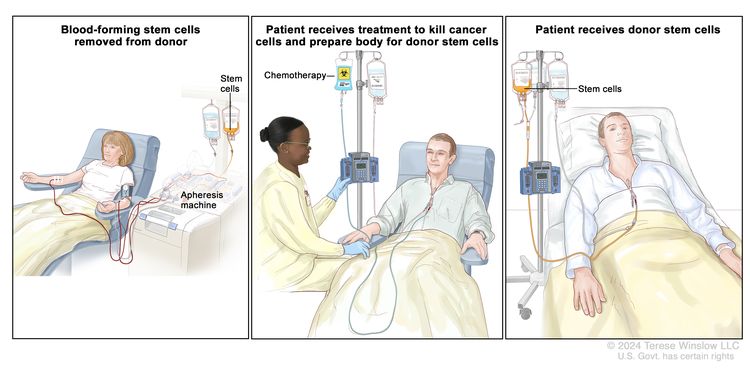
Donor stem cell transplant. (Step 1): Four to five days before donor stem cell collection, the donor receives a medicine to increase the number of stem cells circulating through their bloodstream (not shown). The blood-forming stem cells are then collected from the donor through a large vein in their arm. The blood flows through an apheresis machine that removes the stem cells. The rest of the blood is returned to the donor through a vein in their other arm. (Step 2): The patient receives chemotherapy to kill cancer cells and prepare their body for the donor stem cells. The patient may also receive radiation therapy (not shown). (Step 3): The patient receives an infusion of the donor stem cells.
Donor lymphocyte infusion (DLI)
Donor lymphocyte infusion (DLI) is a cancer treatment that may be used after stem cell transplant. Lymphocytes (a type of white blood cell) from the stem cell transplant donor are removed from the donor's blood and may be frozen for storage. The donor's lymphocytes are thawed if they were frozen and then given to the patient through one or more infusions. The lymphocytes see the patient's cancer cells as not belonging to the body and attack them.
Surgery
Splenectomy is surgery to remove the spleen.
New types of treatment are being tested in clinical trials.
For some people, joining a clinical trial may be an option. There are different types of clinical trials for people with cancer. For example, a treatment trial tests new treatments or new ways of using current treatments. Supportive care and palliative care trials look at ways to improve quality of life, especially for those who have side effects from cancer and its treatment.
You can use the clinical trial search to find NCI-supported cancer clinical trials accepting participants. The search allows you to filter trials based on the type of cancer, your age, and where the trials are being done. Clinical trials supported by other organizations can be found on the ClinicalTrials.gov website.
Learn more about clinical trials, including how to find and join one, at Clinical Trials Information for Patients and Caregivers.
Treatment for chronic myeloid leukemia may cause side effects.
For information about side effects caused by treatment for cancer, visit our Side Effects page.
Follow-up care may be needed.
As you go through treatment, you will have follow-up tests or check-ups. Some tests that were done to diagnose or stage the cancer may be repeated to see how well the treatment is working. Decisions about whether to continue, change, or stop treatment may be based on the results of these tests.
Some of the tests will continue to be done from time to time after treatment has ended. The results of these tests can show if your condition has changed or if the cancer has recurred (come back).
Treatment of Chronic Phase Chronic Myeloid Leukemia
Treatment of chronic phase chronic myeloid leukemia may include:
- targeted therapy (asciminib, imatinib mesylate, nilotinib, dasatinib, bosutinib)
- allogeneic bone marrow transplant or stem cell transplant
Learn more about these treatments in the Treatment Option Overview.
Use our clinical trial search to find NCI-supported cancer clinical trials that are accepting patients. You can search for trials based on the type of cancer, the age of the patient, and where the trials are being done. General information about clinical trials is also available.
Treatment of Accelerated Phase Chronic Myeloid Leukemia
Treatment of accelerated phase chronic myeloid leukemia may include:
- targeted therapy (bosutinib)
- targeted therapy (imatinib mesylate) followed by allogeneic stem cell transplant
Learn more about these treatments in the Treatment Option Overview.
Use our clinical trial search to find NCI-supported cancer clinical trials that are accepting patients. You can search for trials based on the type of cancer, the age of the patient, and where the trials are being done. General information about clinical trials is also available.
Treatment of Blastic Phase Chronic Myeloid Leukemia
Treatment of blastic phase chronic myeloid leukemia may include:
- targeted therapy (imatinib mesylate, dasatinib, nilotinib, bosutinib)
- allogeneic bone marrow transplant or stem cell transplant
- chemotherapy as palliative therapy to relieve symptoms and improve quality of life
Learn more about these treatments in the Treatment Option Overview.
Use our clinical trial search to find NCI-supported cancer clinical trials that are accepting patients. You can search for trials based on the type of cancer, the age of the patient, and where the trials are being done. General information about clinical trials is also available.
Treatment of Relapsed Chronic Myeloid Leukemia
In relapsed chronic myeloid leukemia (CML), the number of blast cells increases after a remission. Treatment of relapsed CML may include targeted therapy (ponatinib or asciminib).
Learn more about these treatments in the Treatment Option Overview.
Use our clinical trial search to find NCI-supported cancer clinical trials that are accepting patients. You can search for trials based on the type of cancer, the age of the patient, and where the trials are being done. General information about clinical trials is also available.
To Learn More About Chronic Myeloid Leukemia
For more information from the National Cancer Institute about chronic myeloid leukemia, visit:
For general cancer information and other resources from the National Cancer Institute, visit:
About This PDQ Summary
About PDQ
Physician Data Query (PDQ) is the National Cancer Institute's (NCI's) comprehensive cancer information database. The PDQ database contains summaries of the latest published information on cancer prevention, detection, genetics, treatment, supportive care, and complementary and alternative medicine. Most summaries come in two versions. The health professional versions have detailed information written in technical language. The patient versions are written in easy-to-understand, nontechnical language. Both versions have cancer information that is accurate and up to date and most versions are also available in Spanish.
PDQ is a service of the NCI. The NCI is part of the National Institutes of Health (NIH). NIH is the federal government’s center of biomedical research. The PDQ summaries are based on an independent review of the medical literature. They are not policy statements of the NCI or the NIH.
Purpose of This Summary
This PDQ cancer information summary has current information about the treatment of chronic myeloid leukemia. It is meant to inform and help patients, families, and caregivers. It does not give formal guidelines or recommendations for making decisions about health care.
Reviewers and Updates
Editorial Boards write the PDQ cancer information summaries and keep them up to date. These Boards are made up of experts in cancer treatment and other specialties related to cancer. The summaries are reviewed regularly and changes are made when there is new information. The date on each summary ("Updated") is the date of the most recent change.
The information in this patient summary was taken from the health professional version, which is reviewed regularly and updated as needed, by the PDQ Adult Treatment Editorial Board.
Clinical Trial Information
A clinical trial is a study to answer a scientific question, such as whether one treatment is better than another. Trials are based on past studies and what has been learned in the laboratory. Each trial answers certain scientific questions in order to find new and better ways to help cancer patients. During treatment clinical trials, information is collected about the effects of a new treatment and how well it works. If a clinical trial shows that a new treatment is better than one currently being used, the new treatment may become "standard." Patients may want to think about taking part in a clinical trial. Some clinical trials are open only to patients who have not started treatment.
Clinical trials can be found online at NCI's website. For more information, call the Cancer Information Service (CIS), NCI's contact center, at 1-800-4-CANCER (1-800-422-6237).
Permission to Use This Summary
PDQ is a registered trademark. The content of PDQ documents can be used freely as text. It cannot be identified as an NCI PDQ cancer information summary unless the whole summary is shown and it is updated regularly. However, a user would be allowed to write a sentence such as “NCI’s PDQ cancer information summary about breast cancer prevention states the risks in the following way: [include excerpt from the summary].”
The best way to cite this PDQ summary is:
PDQ® Adult Treatment Editorial Board. PDQ Chronic Myeloid Leukemia Treatment. Bethesda, MD: National Cancer Institute. Updated <MM/DD/YYYY>. Available at: https://www.cancer.gov/types/leukemia/patient/cml-treatment-pdq. Accessed <MM/DD/YYYY>. [PMID: 26389183]
Images in this summary are used with permission of the author(s), artist, and/or publisher for use in the PDQ summaries only. If you want to use an image from a PDQ summary and you are not using the whole summary, you must get permission from the owner. It cannot be given by the National Cancer Institute. Information about using the images in this summary, along with many other images related to cancer can be found in Visuals Online. Visuals Online is a collection of more than 3,000 scientific images.
Disclaimer
The information in these summaries should not be used to make decisions about insurance reimbursement. More information on insurance coverage is available on Cancer.gov on the Managing Cancer Care page.
Contact Us
More information about contacting us or receiving help with the Cancer.gov website can be found on our Contact Us for Help page. Questions can also be submitted to Cancer.gov through the website’s E-mail Us.
Updated:
Source URL: https://www.cancer.gov/node/4831/syndication
Source Agency: National Cancer Institute (NCI)
Captured Date: 2013-09-14 09:02:28.0








